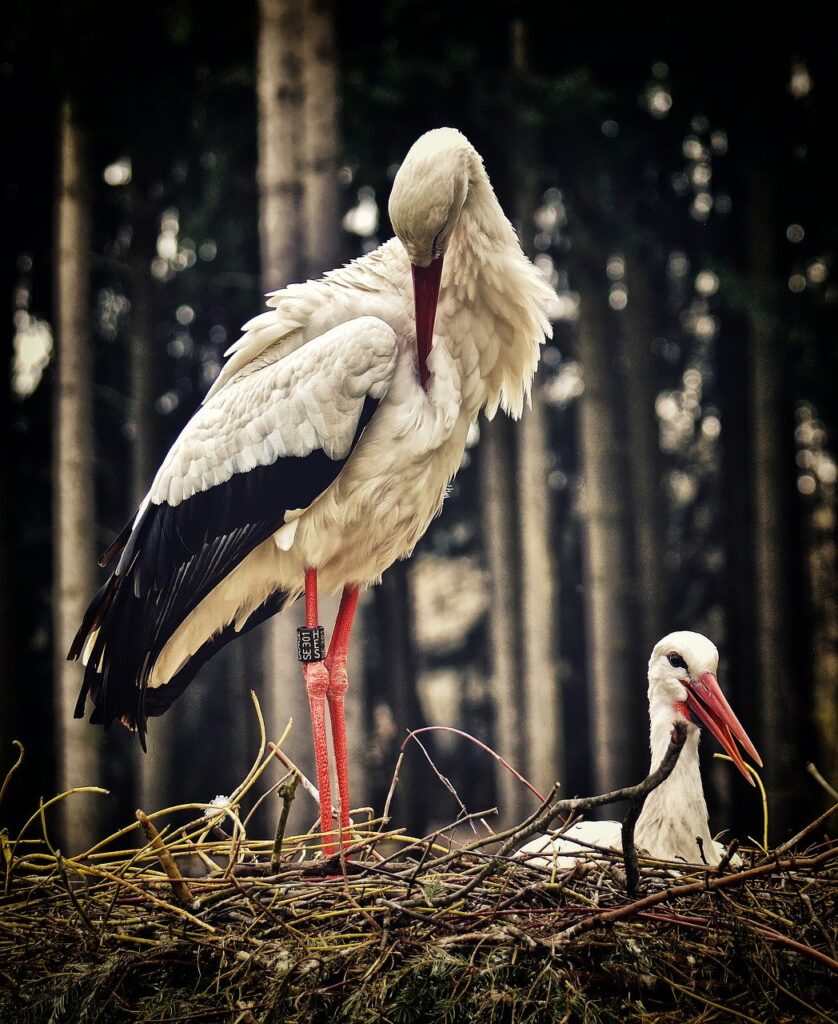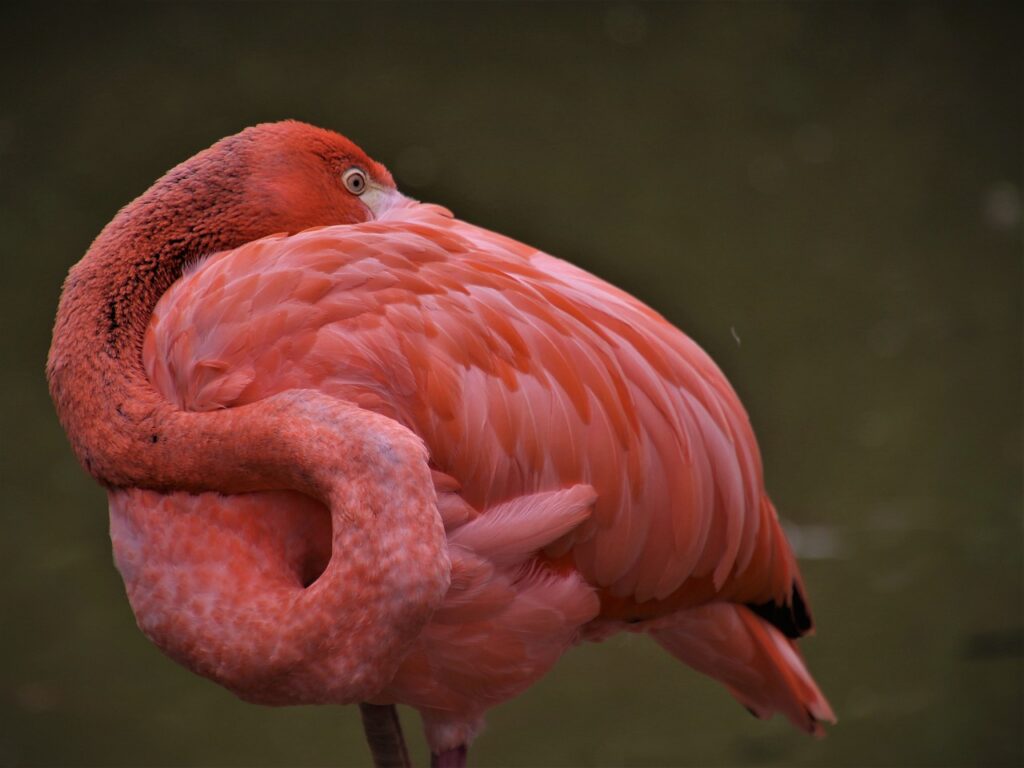Differences Between Flamingos And Storks
Even though flamingos and storks are both large upright birds and live around lakes and marshes – they are very different. They belong to every other bird family and have very different ways of feeding and moving around. They both do have a lot in common, though – including huge wingspans and long legs – but when they are on the ground, you can spot a few tell-tale differences between them.
The 5 Main Ways To Tell Flamingos And Storks Apart:
1: Feeding Styles: Flamingos walkabout when feeding – storks tend to sit still
2: Long Necks: You can always see a flamingo’s full neck – storks tuck them away
3: Beaks: Storks beaks are always straight – flamingos have bent beaks instead
4: Diet: Flamingos are famous for eating teeny plankton – storks go bigger, usually much bigger
5: Color: Flamingos are always totally pink – most storks are monotone
There we have it – an easy to check off the list of simple things that can help you tell apart these two giant birds. Whether it is from a distance or right up close in the zoo – these facts should be perfect. Just remember to look out for the tiny details.

1: One Of The Main Differences Is The Way They Feed:
An easy way to tell them apart is to watch them for a bit. Whether they are out in the wild or a park – they both feed very differently, and this can make it easy to tell them apart. Flamingos are:
- Filter feeders.
- Meaning they have to move through the water constantly.
- Swinging their heads slowly from side to side.

They are always seen feeding in large groups, walking head down into the water, wandering to and fro across a lake or estuary.
Storks, on the other hand, are sit-and-wait predators most of the time. They simply stand themselves in the water on their long legs or sit on a pier or riverbank and stare into the water, waiting. They will often wander about a bit if they see some excellent underwater action before stabbing hard and fast into the water to catch their prey. They can sometimes be seen turning over small rocks and looking under and between things, but generally, they only stab out when they see something tasty.
2: The Way They Hold Their Neck Can Be Key To Identification:
Both flamingos and storks have incredibly long necks – some of the longest in the bird world. However – they hold their necks differently with a minimal overlap – so just watching them for a bit can help. Flamingos always have their necks in a stretched S shape when just standing around. You can always see the entire length of a flamingo‘s neck when it is resting and feeding. Flamingos often sleep with their heads resting on their backs – which storks never do.
Storks, however, scrunch their neck upon themselves and seem to have their heads resting on their shoulders the whole time – almost like they have a short neck. They stay like this all the time they are resting – while watching for the food to swim by and sleeping. They only really stretch and straighten their necks when they are actively hunting and eating. They also eat their food whole – so you can see them straightening their necks and tossing their food into the air to swallow their prey – something flamingos never need to do.
3: They Both Have Different Shaped Beaks:
Not only do they move in different ways – but they also have different facial features. Their beaks – or bills – are designed to do different things. The stork’s beak is a long sharp-pointed tool – usually, around 30cm (1ft) long – and comes in a range of colors, including black, pink, red, and yellow; and can be banded, two-tone, or solid colored. Sometimes they hold it open in the water, hoping fish swim between it.
Flamingos’ beaks are highly specialized. They are filled with horny plates – like combs – that act as filters around the edges. Their beaks are much shorter than a stork’s beak and are always hooked down in the middle and rounded at the end. A flamingo’s beak is never straight or pointed. They are also always black on the tip. They can be white, pinks, or yellow nearer the head – but all end with a black cap.
4: Flamingos And Storks Hunt Out Different Food
The reason they have different shaped beaks is that they eat different shaped things. Nature always moves towards what works best – and this is what the Flamingo’s beak has done. Depending on microscopic plankton to survive, flamingos needed a visor to sieve them out of the water. To do this, they evolved a system similar to whales who feed on the same-sized plankton. As this plankton is throughout the entire water system – flamingos just need to wade back and forth, filtering them out.
On the other hand – storks eat more significant things that move faster – and away from you. This means they needed to develop a longer, more powerful beak for stabbing and grabbing. Feeding on fish, amphibians, insects, and even mammals – they need to be able to grab things that are far away. If they have to get their face right up to a shrew or fish before they can grab it, they will go starving indeed. Having their face so far away from the tip of their beak is what makes them so successful.
5: Both Flamingos And Storks Have Distinctive Color Palettes:
Flamingos are completely bright pink. Storks aren’t. All 6 species of Flamingo appear pink from a distance. Some may have black legs or a yellow face – but overall – pink is what you see. Close up, they are shades of pinks and white and have a large amount of black on their wings – but for comparison to storks – they are pink.
Storks are mainly black, white, or grey. But not boring. They can have very striking patterns and touches of bright color. The Marabou Stork has a pink head and neck – the Lesser Adjutant has a yellow head and neck. The Painted Stork has a yellow bill, red face, pink legs, and a pink bum – very colorful indeed.
Questions and answers
Where Do Storks Build Their Nests?
Storks build their nests in trees and on rooftops in the case of the White Stork (Ciconia ciconia). This bird was so closely associated with humans that they thought that the stork was bringing their babies (as it coincided with a break in the farming year). This fable is still well ingrained in European culture. Most stork nests are massive – being over 1m (3.3ft) wide and at least that deep (often more). They are built purely of twigs every year and can weigh over 60kg for some of the largest storks.
Can You Get White Flamingos?
Yes, you can. Flamingos are only pink because of the compounds digested in their foods. These carotenoids found in the plankton they eat everyday travel through the digestive process and end up in the feathers. Without this exact food, flamingos are just white. If they are ill, sometimes there is a break in their chemistry, and they end up white even if they are still eating this magical food.
Are There Storks In America?
There is only one stork found in the whole of the U.S., and it breeds in Florida. It is the Wood Stork (Mycteria americana) and is over 1m (3.3ft) tall with a wingspan of just under 2m (6.6ft). Found mainly in South America, it can be seen all along the coasts of southern California, all along the Gulf of Mexico, around Florida, and South Carolina.
Can Storks And Flamingos Have Chicks Together?
No. Flamingos and storks are very far apart in bird species – almost as far apart as you can get (like mice and elephants). Although they have evolved to look almost the same – they did it in very different ways and at different times. This means that – just like mice and elephants – there is no way they could successfully breed and produce live young together.
Do Storks Attack Humans?
Answer: No, not on purpose. They may well strike out at a human if they are grabbed or cornered, but they don’t come after you.
Do Flamingos Only Lay One Egg?
Answer: Yes. Flamingos only lay one egg each year in a teeny raised mud nest. They don’t have space or the food to raise more than one each time.
Do Flamingos Feed Their Young Their Blood?
Answer: Sort of. Flamingos produce a bright red ‘milk’ from their crop to feed their young. It is bright red because it contains very nutritious materials from the upper digestive tract and the same carotenoids that make them all pink in the first place. It may contain red blood cells, too – so perhaps it is a bit creepy after all?

